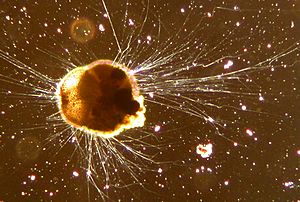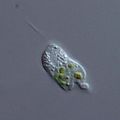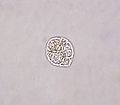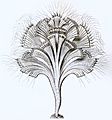Rhizaria facts for kids
Quick facts for kids RhizariaTemporal range: Neoproterozoic - Recent
|
|
|---|---|
 |
|
| Ammonia tepida (Foraminifera) | |
| Scientific classification |
|
| Domain: | Eukaryota |
| (unranked): | Diaphoretickes |
| Clade: | TSAR |
| Clade: | SAR |
| (unranked): | Rhizaria Cavalier-Smith, 2002 |
| Phyla | |
|
Cercozoa |
|
The Rhizaria are a supergroup of mostly unicellular eukaryotes. A multicellular form has recently been described.
This supergroup was proposed by Cavalier-Smith in 2002. It has many species. They vary considerably in form, but for the most part they are amoeba-like with pseudopods. Many produce shells or skeletons, which may be quite complex in structure. They make up the vast majority of protozoan fossils. Nearly all have mitochondria with folds.
Groups
There are three main groups of Rhizaria:
- Cercozoa – Various amoebae and flagellates, usually with pseudopods and common in soil
- Foraminifera – Amoeboids with reticulose pseudopods, common as marine benthos
- Radiolaria – Amoeboids with skeletons, common as marine plankton
Evolutionary relationship
Rhizaria is part of the bikont clade, which also comprises the Archaeplastida, the Chromalveolata, the Excavata, and some smaller, groups. As bikonts, they all descend from a heterotrophic eukaryote with two flagella.
Historically, many rhizarians were considered animals, with their movement and heterotrophy as justification. However, when the five-kingdom system took prevalence over the animal-plant dichotomy, the rhizarians were put into the kingdom Protista. Then, after Carl Woese published his three-domain system, taxonomists turned their attention to the eukaryote domain. The protists are paraphyletic, so needed to be split into monophyletic clades. After much debate, which continues to this day, Rhizaria emerged as one of those monophyletic groups.
Images for kids
-
Foraminiferans (Retaria: Foraminifera)
-
Polycystines (Retaria: Radiolaria)
-
Acantharians (Retaria: Radiolaria)
See also
 In Spanish: Rhizaria para niños
In Spanish: Rhizaria para niños













